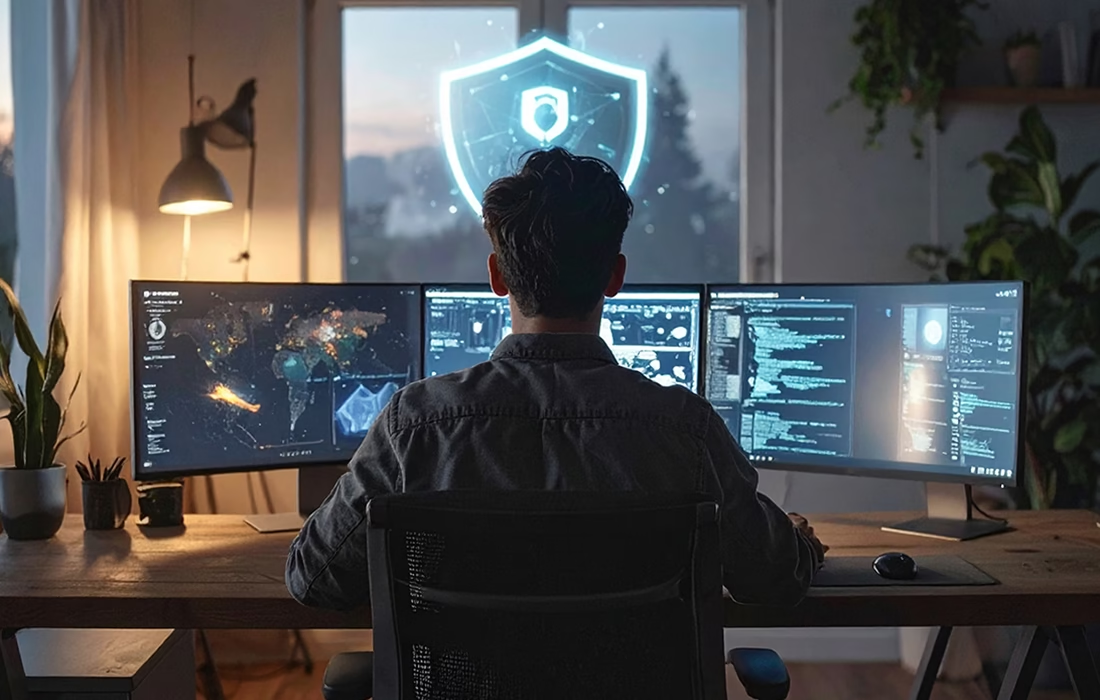Cybersecurity Guide: The Ultimate Beginner’s Tutorial (2025)

Introduction
Cybersecurity guide for beginners: in today’s digital world, protecting your personal information, devices, and online accounts is more important than ever. This guide will walk you through the most common cyber threats, practical safety measures, and simple steps you can take to stay secure online. Whether you’re browsing social media, shopping, or working remotely, following this cybersecurity guide will help you prevent hacking, phishing, and other security risks while building safe online habits from the start. By the end of this article, you’ll have the knowledge to confidently protect your digital life.
What Is Cybersecurity?
Cybersecurity refers to the practice of protecting computers, networks, and data from unauthorized access, theft, or damage. While many people assume it’s only for IT professionals, everyone benefits from basic cybersecurity knowledge. Understanding cybersecurity helps you safeguard personal information, secure devices, and make smarter online decisions. This cybersecurity guide will provide practical advice that anyone can apply, regardless of technical expertise.
Why Cybersecurity Matters for Everyone
Cyber threats aren’t limited to big companies or government agencies. Individuals face daily risks, including identity theft, financial fraud, social engineering scams, and privacy breaches. Even a simple weak password can give hackers access to your email, social media, or banking accounts. Following this cybersecurity guide helps you identify potential risks, understand how attacks happen, and implement practical solutions. The goal is not to make you a cybersecurity expert overnight but to empower you to stay safe while using digital tools and services.
Common Cybersecurity Threats You Should Know
Before you can protect yourself effectively, it’s important to understand common threats:
- Phishing scams – Emails or websites designed to trick you into revealing personal information like passwords or credit card numbers.
- Malware & ransomware – Malicious software that can steal, encrypt, or damage your files.
- Weak or stolen passwords – Easily guessed or reused passwords that hackers can exploit.
- Unsecured Wi-Fi networks – Public networks expose your traffic to attackers who can intercept data.
- Social engineering attacks – Techniques that manipulate you into giving away confidential information.
Being aware of these threats is the first step to defending against them.

Learn more about how phishing attacks work in our guide Phishing Scams Explained: Common Types and How to Avoid Them to spot scams before they trap you.
Simple Cybersecurity Best Practices
Following a few practical steps can dramatically improve your online safety. This cybersecurity guide recommends:
- Use strong, unique passwords for each account, ideally generated by a password manager.
- Enable two-factor authentication (2FA) on all accounts that offer it.
- Keep your operating system, apps, and antivirus software updated regularly.
- Avoid clicking on suspicious links or downloading attachments from unknown sources.
- Install antivirus and firewall tools to provide an extra layer of protection.
- Regularly backup important files to a secure location, like an external drive or cloud storage.
Regular updates prevent cybercriminals from exploiting known weaknesses. Read The Importance of Software Updates: Why Installing Patches Protects You to understand why staying current is essential.
Cybersecurity for Mobile Devices
Smartphones and tablets contain much of our personal information, including emails, photos, banking apps, and passwords. Securing these devices is just as important as protecting your computer. To keep your mobile devices safe:
- Only download apps from official app stores like Google Play or the Apple App Store.
- Check app permissions and avoid granting access to sensitive data unnecessarily.
- Keep your operating system and apps up-to-date with the latest security patches.
- Avoid using unknown or unsecured Wi-Fi networks, especially for financial transactions.
- Consider using a VPN on public networks to encrypt your connection.

Protecting Your Privacy Online
Cybersecurity isn’t just about stopping hackers — it’s also about controlling your personal information. This cybersecurity guide suggests:
- Use a VPN to hide your online activity, especially on public Wi-Fi.
- Review privacy settings on social media platforms to limit who can see your posts and personal details.
- Be mindful of oversharing sensitive information online.
- Use secure browsers and privacy-focused extensions to reduce tracking and improve security.
The Future of Cybersecurity
As technology advances, so do cyber threats. The rise of artificial intelligence, smart home devices, and the Internet of Things (IoT) introduces new vulnerabilities. Staying informed about emerging threats is crucial. This cybersecurity guide emphasizes adopting safe online habits today to prepare for future risks. Learning the basics now makes it easier to adapt to new tools and security practices as technology evolves.
Conclusion
Cybersecurity doesn’t have to be overwhelming. By following the steps in this cybersecurity guide — using strong passwords, enabling 2FA, keeping devices updated, and practicing safe online habits — you can significantly reduce your risk. Remember, online safety is about consistent, practical habits, not technical expertise. Start implementing these practices today to protect your digital life and enjoy the internet with confidence.
Trusted Resources & Further Reading
If you want to explore more verified cybersecurity guidance, these trusted organizations and resources provide expert information and tools for staying safe online:
- CISA – Cybersecurity Best Practices – The U.S. Cybersecurity and Infrastructure Security Agency’s official advice for individuals and businesses to reduce cyber risks.
- PrivacyGuides.org – A non-profit resource offering detailed recommendations on secure software, VPNs, and privacy-focused tools.
- NIST Cybersecurity Framework – U.S. National Institute of Standards and Technology’s globally respected framework for managing and improving cybersecurity posture.
- Microsoft Security Blog – Regularly updated with insights on modern threats, ransomware defenses, and identity protection.
- Europol Cybercrime Centre (EC3) – Europe’s central authority for tracking cyber-criminal activities and providing educational resources.




2 thoughts on “Cybersecurity Guide: The Ultimate Beginner’s Tutorial (2025)”